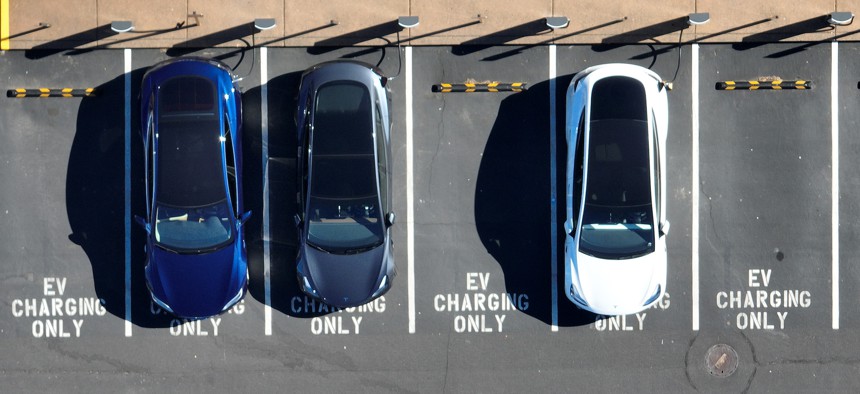In Race to Build Out EV Charging Stations, Some Cities and States Have a Leg Up

Tesla cars recharge at a Tesla charger station on February 15, 2023 in Corte Madera, California. Electric car company Tesla is partnering with the U.S. federal government to expand electric vehicle charging infrastructure in the United States. Justin Sullivan via Getty Images
As the number of electric vehicles surge, a new ranking looks at the state of charging infrastructure and which cities and states are ready to receive them.
In his 2021 infrastructure law, President Joe Biden vowed to dramatically increase the number of electric vehicles on the road. One of his goals—installing 500,000 new chargers across the U.S.—took aim at a common dilemma for EV owners: Where to plug in?
Depending on how “EV-friendly” the state or city, the answer can either be easy or require a lot of searching, according to a new report that ranks states and cities on their charging infrastructure.
The ranking from the automobile search engine iSeeCars.com looks at the charger-to-resident ratio to determine “the most and least EV-friendly states.” Its analysis comes at an unprecedented time of investment in EV charging infrastructure by state and local governments following the 2021 law, which allocated $5 billion to be handed out under the National Electric Vehicle Infrastructure (NEVI) program.
Ranking by State
Topping the list as the “most EV-friendly” is Vermont, with one EV charger for every 703 residents. California was next, followed by Massachusetts, Colorado and Rhode Island to round out the top five.
At the bottom is Indiana, Alaska, Kentucky, Louisiana, and, with 9,275 residents per charger, Mississippi.
But using money from NEVI, these states are working to improve their charging infrastructure. In Louisiana, the department of transportation and development plans to install public chargers spaced no more than 50 miles apart and within one mile of highway intersections and exits. Meanwhile, Indiana has received $100 million to build out its EV charging station network and has made headlines for developing pavement that wireless charges cars as they move.
The analysis takes into account that not all chargers are created equal. Tesla vehicles, for example, use chargers that are often incompatible with other EVs. Then there are different charging speeds. The rankings vary slightly when considering these varieties. For non-Tesla drivers looking for fast chargers, for instance, Oklahoma ranks No. 1.
But those differences will soon start to matter less and less. Last week, the Biden administration announced guidelines to standardize public charging stations and announced that Tesla has agreed to open its Supercharger network to non-Tesla owners by the end of 2024.
City Ranking
The surge in EVs affects cities in particular because they face the challenge of figuring out where to install chargers in the first place. As Route Fifty reported last year, “their approaches have varied considerably, from installing chargers on city-owned streetlights in Los Angeles to partnering with private charging companies in places like San Antonio and Hoboken, New Jersey. Decisions local governments and industry are making now are likely to affect how the charging landscape looks for years to come.”
For now, in the iSeeCars ranking, three California cities took the top spots: the San Francisco/Oakland/San Jose area, San Diego and Los Angeles. California’s struggles with high gas prices and its ambitions to ban vehicles with internal combustion engines by 2035 has made EV adoption and infrastructure a top priority in the state. Outside of California, Denver has the most charging ports per resident.
On the flip side, three Texas cities—San Antonio, Houston and Dallas-Fort Worth—fall in with the 10 least EV-friendly cities. The honor for the worst, however, goes to St. Louis, Missouri, with 5,787 residents per charger.
The analysis uses data from the U.S. Department of Energy’s Alternative Fuel Data Center through early February.
To read the full report, click here.





